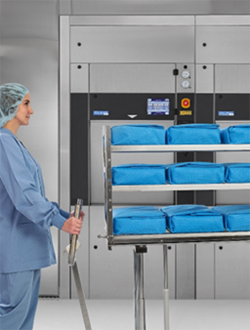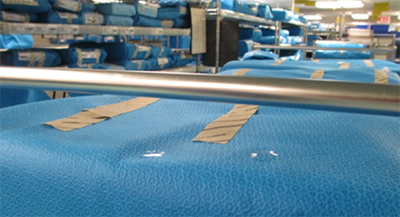Knowledge Center
June 30, 2021
Improve Steam Sterilizer Load Drying: Stop Cracking the Sterilizer Door

Cracking the door at the end of a steam sterilization cycle goes back to the days of gravity-only sterilization cycles when woven cotton muslin wraps with good absorption properties were commonly used to wrap instrument sets. With the reduced likelihood of external water, and in the absence of modern mechanical vacuum systems, cracking the door to allow drying of muslin wrapped packs was an acceptable method to help ensure dry packs.
Today, in the age of less absorbent non-woven wraps, AAMI ST79 recommends that SPD professionals reject any wrapped pack with external moisture droplets at the end of a steam sterilization cycle1. This is to prevent potential recontamination of the instrument set by wicking of microorganisms through the wrap. Since no wrap manufacturer can guarantee sterility when there are visible water droplets on the outside of a pack, this also means that personnel must not use the cracked-door technique to dry the packs.
Effects of Temperature During Steam Sterilization
What should sterile processing personnel do to help ensure dry loads?
In the case of sterilized packs with internal moisture, leaving products in the sterilizer with the door cracked to assist drying may not work as well as pulling the load out of the sterilizer and into the cool-down area. If the sterilization wrapper does not have external moisture, and the pack is not handled until cooled to room temperature, the wrapper will protect the inside of the pack from contamination, even if the inside of the pack is still slightly damp.
When a load is left in the sterilizer with the door cracked, the temperature inside the chamber is still very hot. The differential between the pack and the temperature inside the chamber is minimal, and not much more than 20°. The humidity inside the sterilizer is also not as low as it is outside, so any moisture that is still in the pack doesn’t have much motive force to be driven outside of the pack. Because of the physics involved, leaving a load inside the sterilizer with the door cracked may inhibit the drying process. If a processed load is left to sit in the sterilizer with the door cracked, the latent heat in the instruments dissipates, and the temperature differential is less. Therefore, excess moisture is less likely to evaporate when the load is removed, potentially contributing to wet packs.
In contrast, when a pack is removed from the sterilizer, it remains hot from the sterilization cycle, usually more than 200°F (93°C). If the load is moved into the cool-down area, where the temperature is generally maintained between 68° and 75°F (20° to 24°C), the temperature differential between the inside of the pack and the cool-down area is approximately 130°F (54°C). This differential, in addition to the much lower humidity outside the chamber, will help to drive off the moisture from the inside of the pack.
Proper Steam Sterilization Load Cooling
It is no longer necessary to crack the sterilizer door following a steam sterilization cycle and it may hinder the drying process.
Once a cart is removed from the sterilizer and packs have reached room temperature, there is no temperature differential, and the drying process is complete. This is the reason for allowing packs to cool for at least an hour after processing. It is also extremely important to avoid placing hot sterilized loads directly under air conditioning vents during the cool-down process. This would be as detrimental as placing hot sterilized packs on a cold, solid, metal shelf. The pack would cool far too quickly, resulting in condensation or "sweating" of the packs. The moisture that remains in the pack will become condensate instead of being driven off as vapor, causing the load to be considered contaminated and in need of reprocessing.
How to Avoid Wet Packs
 A wet pack can cause contamination issues and can lead to re-contaminating your sterilized load. A wet pack is the presence of any moisture (internal or external) left in or on a package after sterilization. If a healthcare facility is experiencing problems with external moisture on packages, there is an underlying issue that absolutely must be addressed, whether it is a problem with excessively wet steam, poor loading techniques, or a true sterilizer malfunction.
A wet pack can cause contamination issues and can lead to re-contaminating your sterilized load. A wet pack is the presence of any moisture (internal or external) left in or on a package after sterilization. If a healthcare facility is experiencing problems with external moisture on packages, there is an underlying issue that absolutely must be addressed, whether it is a problem with excessively wet steam, poor loading techniques, or a true sterilizer malfunction.Over time, sterile processing staff members have used a variety of methods to compensate for poor steam quality, including the use of linen shrouds and absorbent shelf and tray liners. Cracking the steam sterilizer door is NOT the answer. The best thing to do is to perform a thorough wet pack investigation to find the root cause of the moisture and work diligently toward resolving the underlying issue.
Although acceptable in the days of gravity-only cycles and muslin sterilization wrap, it is no longer necessary to crack the sterilizer door following a steam sterilization cycle and it may hinder the drying process. The door-cracking process has been passed down in sterile processing departments over the years as a natural and necessary part of the sterilization process. Removing the load immediately following completion of the sterilization cycle improves both drying and SPD productivity. By allowing the cooling process to begin as soon as possible, the sterilizer is also available for additional loads to be processed.
Explore STERIS Steam Sterilizers
Related Resources
Article References
1 Association for the Advancement of Medical Instrumentation, ANSI/AAMI ST79:2017, Annex O, Moisture Assessment
2 Cracking the Steam Sterilizer Door: Dispelling the Myth, by Linda Clement and John Bliley, STERIS plc, May 2007



